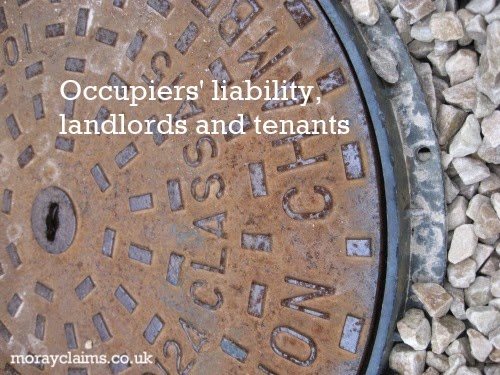
Occupiers’ liability may apply where a defective drain cover causes an accident on premises
In this post, we are looking at situations where you might have a claim for injury following an accident on premises owned or occupied by someone else.
In Scotland, the Occupiers’ Liability (Scotland) Act 1960, requires occupiers of premises to take reasonable care for people who come onto their premises to see to it that they are not injured due to the state of the premises.
While this is a statutory duty, because the obligation imposed is to take reasonable care, you still have to prove fault, as under the general law of negligence.
Often this will mean it is necessary to gather evidence about how long the hazard in question had been in existence before the accident.
The argument you have to counter is that, if the defect had not been there for very long before the accident, there was not sufficient time for the occupier to identify it and repair it before any accident happened and so they were not negligent.
Who is an occupier?
It is the person (or organisation) who has control and possession of the premises at the time of the accident.
In other words, it is the person who can determine who can and cannot come onto the premises.
You can see that that person will not necessarily be the owner of the premises.
What are premises?
They include fixed and moveable structures and vessels, vehicles or aircraft.
Typical examples are: offices, shops and supermarkets; hotels and nightclubs; some open areas of land, such as car parks, railway station platforms and public parks; and private and rented property.
Landlord and tenant situations
If you live in rented accommodation and are injured within it or in the immediate vicinity, you may have a claim based on duties which the law implies into these contracts of lease.
The landlord has to make sure the property is wind and watertight, and also reasonably fit for human habitation, both at the beginning of, and throughout, the tenancy.
If you are injured while making normal, everyday use of the property, that will tend to indicate that the property is not in all respects reasonably fit for human habitation.
Any unsatisfactory elements of the property which affect its habitability ought to be established at the outset of the tenancy by the inspection which the landlord has to carry out before the new tenant moves in.
After you have moved in, it will be up to you, as the tenant, to report to your landlord any defects which appear, otherwise the landlord will not be liable if you are injured because they won’t know the problem had arisen and the repairing obligation will not have been triggered.
In one case we had, our tenant client fell through the floor of her rented accommodation and was injured.
The floorboards proved to be riddled with woodworm.
As she had only lived in the house for a few weeks before the accident, it was possible to infer that the infestation had been there at the start of the tenancy and a reasonable inspection by the landlord ought to have discovered it.
Accordingly, we established liability on the part of the landlord.
What about visitors to rented accommodation?
Where you are injured on premises where, at the time, you are visiting the tenant, you do not have any contract with the landlord.
In this situation, the 1960 Act provides a possible route to making a claim.
If the landlord is responsible for repair and maintenance of the property (which he usually is), he owes the same duty to persons using the property as he does to the tenant.
So, for example, in one reported case, the child of a tenant was able to claim following injury caused by a defective toilet bowl. It had been reported to the landlord but not repaired.
We had a case where a person visiting a relative in Elgin fell into a manhole in the front garden of the property because the lid had not been properly screwed down when it was originally installed. That injury claim was successful under the “visitor” provision in the 1960 Act.
Practical points
The main point to take from this is that it is important to report to the appropriate person or authority any potentially dangerous defects you find – whether they are on “premises” or not.
There are some similarities here with the legal basis for pavement tripping claims.
By reporting any hazard, you set up a legal duty on the responsible person to investigate and fix the problem, if necessary, within a reasonable time.
In this way, you may prevent an accident happening – where you could end up being the victim.
On the other hand, if the repair is not carried out and someone does get injured, the fact that the duty holder was “on notice” means they will have a better chance of making a successful compensation claim for the harm they have suffered.
How to get in touch with us for help
If you have any questions about issues raised by this article or about our personal injury services, generally, please contact us.
We – Peter and Marie – are available via 01343 544077 or you can send us a Free Online Enquiry via the Moray Claims website.
All initial enquiries are free of charge and you are not obliged to take matters further. We will be happy to help – either directly or by referring you onto someone else better placed – if we can.
Remember that we are lawyers with accredited expertise in personal injury law and the Elgin office of Grigor & Young, Solicitors and Estate Agents (where Moray Claims is based), has corporate accreditation from the Association of Personal Injury Lawyers (APIL).